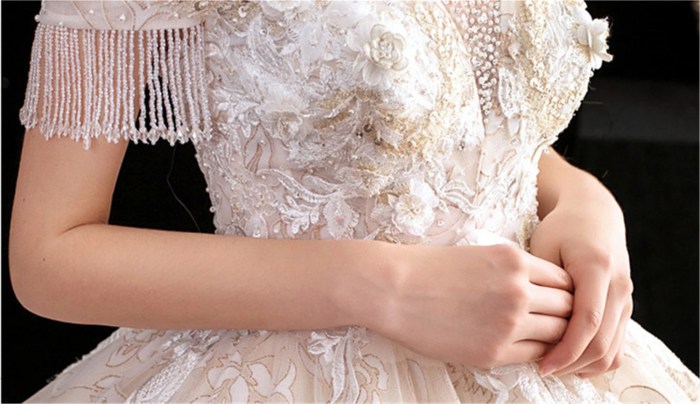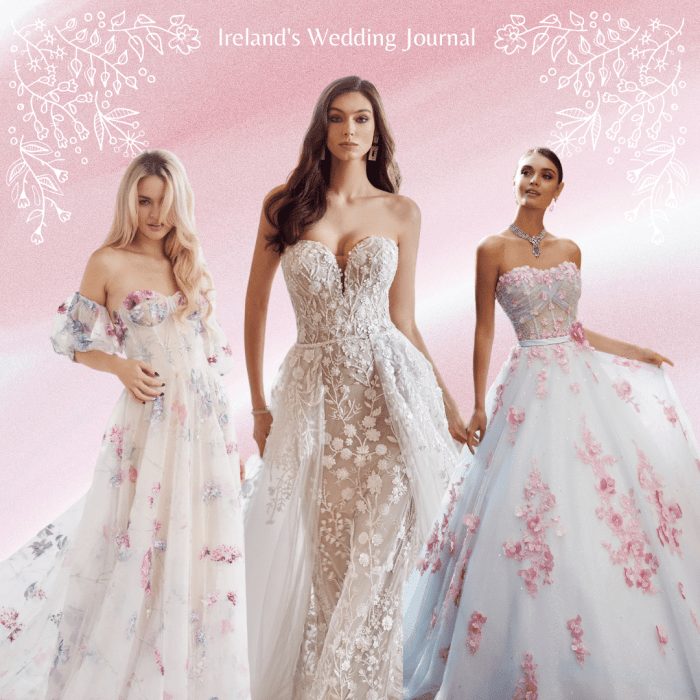Flower Embroidered Wedding Dresses: A Timeless Trend

Source: etsystatic.com
The timeless elegance of flower embroidered wedding dresses continues to captivate brides worldwide. From delicate floral accents to bold, statement pieces, embroidered designs offer a unique way to personalize a wedding gown and reflect individual style. This exploration delves into the design inspiration, embroidery techniques, color palettes, dress silhouettes, and illustrative examples of this enduring bridal trend.
Design Inspiration & Trends
The evolution of flower embroidered wedding dresses mirrors broader fashion trends, adapting to different eras and aesthetics. Victorian-era gowns often featured densely embroidered floral motifs, reflecting the era’s romantic and ornate style. The Art Deco period saw a shift towards geometric floral patterns and streamlined designs. Modern interpretations often blend traditional embroidery techniques with contemporary silhouettes and color palettes.
| Style Name | Description | Example Fabrics |
|---|---|---|
| Romantic Floral | Features densely embroidered flowers, often incorporating various blooms and lush greenery, creating a rich and opulent look. | Silk organza, lace, tulle |
| Minimalist Wildflower | Emphasizes delicate, scattered wildflowers, creating a subtle and understated aesthetic. | Lightweight silk, crepe, cotton |
| Modern Geometric Floral | Incorporates stylized floral patterns with geometric elements, offering a contemporary and sophisticated feel. | Silk charmeuse, satin, mikado |
The choice of flower type significantly impacts the overall aesthetic. Roses evoke romance and classic elegance, lilies symbolize purity and grace, while wildflowers lend a bohemian or rustic charm. For instance, a dress embroidered with cascading roses would convey a different feeling than one adorned with scattered daisies.
A flower embroidered wedding dress offers a delicate and romantic aesthetic, perfect for a spring or summer celebration. If you’re attending a semi-formal wedding as a guest, however, you might find inspiration in the array of stylish options available; check out this helpful guide on dresses to wear to a semi formal wedding for ideas. Returning to the bride’s attire, the intricate embroidery on a flower embroidered wedding dress adds a unique and personalized touch to the overall bridal look.
Embroidery Techniques & Materials
Several embroidery techniques contribute to the unique beauty of flower embroidered wedding dresses. Hand embroidery offers unparalleled detail and artistry, while machine embroidery allows for greater speed and consistency. Beading adds texture and sparkle, enhancing the overall richness of the design. The choice of technique often depends on the desired level of detail, budget, and time constraints.
Different embroidery threads impact the final appearance and craftsmanship. Silk threads create a soft, luxurious sheen, while cotton threads offer durability and a more matte finish. Metallic threads add a touch of glamour and sparkle. The choice of thread often depends on the desired aesthetic and the overall design of the dress.
- Silk: High cost, luxurious sheen, moderate durability.
- Cotton: Low to moderate cost, matte finish, high durability.
- Metallic: Moderate to high cost, shimmering effect, moderate durability.
Color Palettes & Design Elements, Flower embroidered wedding dress
The color palette plays a crucial role in setting the mood and style of a flower embroidered wedding dress. Three distinct palettes offer diverse aesthetic possibilities.
- Romantic Palette: Soft pastels like blush pink, ivory, and light lavender create a dreamy, romantic atmosphere.
- Modern Palette: Bold jewel tones such as emerald green, sapphire blue, and ruby red offer a contemporary and sophisticated feel.
- Vintage Palette: Warm neutrals like cream, beige, and gold evoke a classic, timeless elegance.
Embroidery placement significantly affects the overall design. Neckline embroidery adds a delicate touch, bodice embroidery creates a focal point, and skirt embroidery adds movement and visual interest. The choice of placement depends on the desired emphasis and the overall silhouette of the dress.
Floral patterns contribute to the overall aesthetic. Scattered patterns create a whimsical feel, clustered patterns add visual weight, and repeating patterns offer a structured and formal look. The choice of pattern depends on the desired level of formality and the overall design aesthetic.
Dress Silhouettes & Embroidery Integration
Flower embroidery complements various wedding dress silhouettes. On an A-line dress, embroidery can enhance the graceful flow of the skirt. On a mermaid silhouette, it can accentuate the curves. On a ballgown, it can add texture and visual interest to the voluminous skirt. The choice of silhouette and embroidery style should complement each other to create a harmonious and balanced design.
The scale and density of the embroidery impact the visual weight and balance. Delicate embroidery creates a light and airy feel, while dense embroidery adds drama and visual impact. The choice of scale and density depends on the desired aesthetic and the overall design of the dress.
Negative space in flower embroidery designs is crucial. It allows the eye to rest and prevents the design from feeling overwhelming. Strategic use of negative space enhances the overall aesthetic by creating visual balance and emphasizing specific floral motifs.
Illustrative Examples

Source: weddingjournalonline.com
Imagine a wedding dress featuring intricate floral embroidery on a lace bodice and a flowing tulle skirt. The embroidery style is a mix of hand and machine embroidery, incorporating roses, lilies, and forget-me-nots in shades of ivory, blush pink, and light blue. The overall silhouette is a classic A-line, creating a romantic and elegant look.
Consider a minimalist wedding dress featuring delicate embroidered wildflowers scattered across the skirt. The fabric is a lightweight silk crepe, the embroidery technique is hand embroidery using fine cotton threads in muted shades of white, cream, and pale green. The color palette is understated and elegant.
Envision a wedding dress with bold, statement flower embroidery on the back. The design features large, stylized peonies and roses in deep burgundy and emerald green, embroidered using a combination of machine and hand embroidery techniques on a luxurious silk charmeuse fabric. The embroidery style is dramatic and eye-catching, creating a striking focal point.
Questions and Answers
How do I care for a flower embroidered wedding dress?
Dry cleaning is generally recommended to preserve the embroidery and fabric. Always check the care label for specific instructions.
Can I customize the embroidery design on my dress?
Most designers offer customization options. Discuss your vision with a designer to create a unique floral embroidery design.
What is the typical cost of a flower embroidered wedding dress?
The price varies greatly depending on the complexity of the embroidery, fabric choice, and designer. Expect a higher price point compared to a plain wedding dress.
How long does it take to create a flower embroidered wedding dress?
The creation time depends on the complexity of the design and the designer’s workload. Allow ample time, potentially several months, for bespoke designs.
